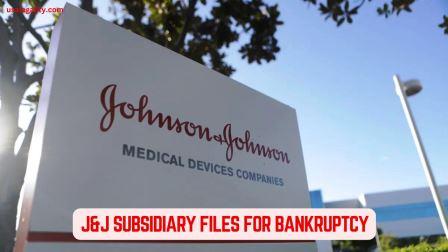In a major legal development, a Johnson & Johnson (J&J) subsidiary files for bankruptcy to advance an $8 billion settlement. This action seeks to resolve tens of thousands of lawsuits alleging that J&J’s talc-based products, such as baby powder, caused cancer. The filing marks the third time J&J has attempted to use bankruptcy as a strategy to settle these claims. This blog will explore the background of these lawsuits, details of the bankruptcy filing, and the potential implications for J&J and the affected plaintiffs.
Background of the Talc Lawsuits
Johnson & Johnson has faced over 62,000 lawsuits from individuals who claim that its talc products were contaminated with asbestos, leading to various cancers, primarily ovarian cancer. While J&J continues to insist that its products are safe, many plaintiffs argue otherwise. These lawsuits have led to both legal victories and losses for J&J, with some plaintiffs securing multibillion-dollar verdicts. However, the company’s efforts to avoid future claims have led to this third bankruptcy filing.
J&J’s talc products have been widely used for decades, with baby powder being one of its most iconic offerings. The lawsuits began after studies suggested a possible link between talc and cancer. While J&J has denied these claims and stood by the safety of its products, the sheer number of lawsuits and some large jury awards have put the company under immense pressure. The company has attempted various legal strategies to mitigate its exposure, including two previous bankruptcy filings, both of which were rejected by the courts.
J&J Subsidiary Files for Bankruptcy to Advance $8 Billion Talc Settlement
In its third attempt to resolve the talc litigation through bankruptcy, J&J established a new subsidiary, Red River Talc LLC, to handle the liabilities related to these claims. This subsidiary filed for Chapter 11 bankruptcy in the U.S. Bankruptcy Court for the Southern District of Texas. The “Texas two-step” bankruptcy strategy allows J&J to shield its assets while offering a substantial settlement to claimants. The $8 billion settlement has already garnered the support of approximately 83% of current claimants, exceeding the 75% threshold required for court approval. This strategic move is aimed at settling all talc-related claims collectively, providing a more efficient resolution for both the plaintiffs and the company.
The decision to file for bankruptcy again comes after J&J’s previous two attempts to settle these claims through similar maneuvers were blocked by federal courts. Despite these setbacks, the company believes it now has enough support to successfully implement the plan. The settlement focuses on claimants alleging ovarian cancer and other gynecological issues, building upon previous agreements J&J reached with state attorneys general and those who developed mesothelioma, a rare cancer linked to asbestos exposure.
J&J Subsidiary Files for Bankruptcy: Legal Implications and Challenges
While the proposed settlement has the support of a majority of claimants, it still faces significant legal hurdles. A recent U.S. Supreme Court decision in June involving Purdue Pharma’s bankruptcy filing could impact the outcome of J&J’s strategy. The court ruled against Purdue Pharma’s use of bankruptcy protection to settle its opioid-related liabilities, raising questions about whether financially healthy companies like J&J can use similar strategies to resolve mass tort claims. Additionally, proposed federal legislation aims to prevent such companies from benefiting from bankruptcy protection, further complicating J&J’s efforts.
Opponents of J&J’s bankruptcy filing argue that the company is using this legal maneuver to avoid fully compensating the plaintiffs. They claim that J&J, with its vast financial resources, should not be allowed to use bankruptcy as a shield while plaintiffs who have suffered from cancer continue to fight for justice. Despite these objections, J&J remains committed to pushing forward with its settlement plan, stating that it offers a fair and efficient resolution to the ongoing litigation.
J&J’s Bankruptcy Strategy: The Texas Two-Step
The “Texas two-step” bankruptcy strategy employed by J&J has become a controversial legal maneuver. It involves creating a new subsidiary to take on the liabilities related to a particular issue—in this case, the talc litigation—and then filing for bankruptcy on behalf of the subsidiary. This allows the parent company to avoid filing for bankruptcy itself while potentially resolving mass tort claims through a single global settlement. Bankruptcy judges can enforce such settlements, halting all related lawsuits and preventing new ones from being filed.
One of the key reasons J&J opted for this strategy is the potential to avoid the ongoing threat of multibillion-dollar verdicts. Outside of bankruptcy, any settlement the company reached with some claimants would still leave open the possibility of future lawsuits, exposing J&J to further financial risk. By filing for bankruptcy through a subsidiary, J&J hopes to bring all claimants under one settlement, avoiding the uncertainty of ongoing litigation.
Potential Impact of the $8 Billion Settlement
If the bankruptcy court approves the proposed settlement, it would represent one of the largest settlements in a mass tort case. The $8 billion deal would provide compensation to tens of thousands of individuals who have alleged harm from J&J’s talc products. For claimants, the settlement offers a more streamlined and efficient resolution than pursuing individual lawsuits, which could take years to resolve and result in varied outcomes.
For J&J, the settlement could bring closure to a legal battle that has plagued the company for years. By settling the talc claims collectively, the company would be able to move forward without the looming threat of additional lawsuits. However, J&J’s legal strategy still faces significant challenges, and the outcome of the bankruptcy proceedings will ultimately determine whether the company’s approach is successful.

1 thought on “J&J Subsidiary Files for Bankruptcy to Advance $8 Billion Talc Settlement”